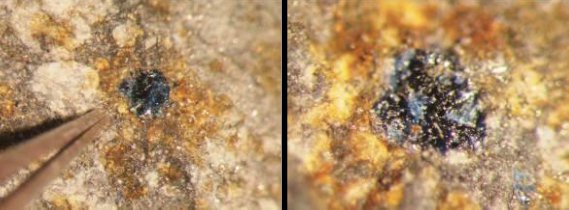
May 24, 2019
Research Highlight
A Cold Clast in the Zag Meteorite

A blue halite hosted in Zag (JSC) with tips of tweezer for scale. Size of the crystal is ~2 μm.Image credit: Chan et al. (2016).
Scientists have reported the results of organic and isotope analyses of the Zag meteorite. The team examined a large aggregate from a centimeter-sized clast in the thermally-metamorphosed H ordinary chondrite. The study reveals differences in the composition of Zag compared to primitive (CI,CM,CR) carbonaceous chondrites. Results indicate that the aggregate at the center of the study was formed in extremely cold conditions, possibly in the interstellar medium or the outer reaches of the solar nebula as the Solar System was forming.
The Zag meteorite fell to Earth in 1998, touching down on a mountain in the vicinity of Zag, Morocco.
The study, “A novel organic-rich meteoritic clast from the outer solar system,” was published in the journal Nature: Scientific Reports. This work was supported by the Emerging Worlds Program. The NASA Astrobiology Program provides resources for Emerging Worlds and other Research and Analysis programs within the NASA Science Mission Directorate (SMD) that solicit proposals relevant to astrobiology research.
Additional Links:
Amino Acids in the Zag Meteorite
Water-bearing salt crystals come from dawn of solar system, UK researchers report in Science (NASAJPL)